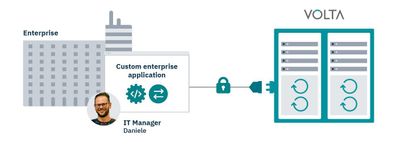Break down data silos and democratize the simulation process with APIs
Written by Matteo Gazzin
30 June 2021 · 5 min read

In today’s data-driven businesses, accessing enterprise-wide information is a must to maximize operational efficiencies and discover new opportunities. According to Mulesoft’s 2021 Connectivity Benchmark Report, nine out of ten IT leaders consider data silos as the main cause of significant business problems for most enterprises.
What are data silos?
A data silo typically consists of a set of data held by one group (or software) that is not easily or fully accessible by other groups (or software). Within a company, each department collects and stores its own data for its own purposes using software that is often dedicated to their specific topic. Different software might collect the same data multiple times, creating an intrinsic inconsistency. To overcome this, one obvious solution would be to store all the data in a single place, often defined as “Data Lake”, and extract insights from there.

Source: Web Amazon Services
A Data Lake, however, collects data coming from different systems in their own raw format, and it is practically impossible to extract valuable information and meet every department business needs using a single system.
APIs are key to building better digital experiences
The use of APIs would be the preferred choice to develop a modular and scalable solution. In this way, you can integrate different systems even though they were never intended to interoperate.
Indeed, a business unit decides to use a specific enterprise application because it does something better than others, and at some point, whatever this application does, can be useful for other business units at a different point in the value chain. Because of that, ideally, every enterprise application should have an “API mindset” by exposing the valuable information and strengths that it manages to any internal or external integrator.
This is somehow confirmed by the Google Cloud 2020 State of APIs report. Indeed, only 40% of IT decision-makers consider APIs as a way to do system integration while 56% of them see APIs as assets that help organizations build better digital experiences and products.

Source: Google Cloud 2020 State of APIs report
Cultivating an API culture is not something completely new for successful companies. Back in early 2000, Jeff Bezos, CEO of Amazon, issued an internal mandate to all his employees, which mainly stated as follows (you can read more about "The Secret to Amazon's Success Internal APIs":
- All teams will henceforth expose their data and functionality through service interfaces and communicate with each other through these interfaces
- There will be no other form of inter-process communication allowed: no direct linking, no direct reads of another team’s data store, no shared-memory model, no back-doors whatsoever. The only communication allowed is via service interface calls over the network
- All service interfaces, without exception, must be designed from the ground up to be externalizable. That is to say, the team must plan and design to be able to expose the interface to developers in the outside world. No exceptions.
In a few words, he was asking every team to define the resources they had and expose them to all other teams through an API interface.
Unleash the full power of engineering data with VOLTA APIs
The engineering and simulation world makes no difference: CAD data are stored in PDM/PLM applications, requirements are stored in requirements management applications, and simulation data are handled by Simulation Process and Data Management (SPDM) platforms. Integrating them is required to have full traceability throughout the product development chain.
This is why back in 2019 we decided to unleash the full power of VOLTA, our collaborative web platform for Simulation Process and Data Management (SPDM) and design optimization. We exposed our APIs and let companies securely connect their apps, platforms, services, and systems with the VOLTA platform. This enabled non-simulation experts, suppliers, and even clients to interact with the engineering data they need, instead of getting lost with the complexity of the whole simulation process.
With the VOLTA APIs, a developer can take advantage of the VOLTA execution ecosystem and create a simplified user experience to give a non-expert user the possibility to execute a simulation without even knowing what’s happening in the background: everything is preconfigured by the simulation expert.

This opens a wide range of use cases where the simulation can be applied to have quick insights into real-time data. Imagine a company that produces beams: at catalog, you have hundreds of beams and you have a bunch of simulations executed for them. Sometimes, the customer request is slightly different from what the catalog offers: maybe the customer needs a thinner beam with nearly the same mechanical characteristics as the catalog item. Thanks to the VOLTA APIs, a sales representative can request a simulation of the desired beam directly from the Customer Relationship Management (CRM) system and quickly provide an estimation to the customer.
With the proliferation of tools used in the engineering process and the ever-increasing product complexity on one side and shorter development cycles on the other, the challenge is to make the entire process more immediate and less cumbersome for users across the enterprise. Exploiting VOLTA APIs programming capabilities, you can meet the needs of the user exactly where he is, within the interface, he is accustomed to.
Learn more about VOLTA APIs capabilities.
White paper


